10 Ways Content Consumption Is Changing and How to Change with It
If a tree falls in the forest, does anyone hear it? And if no one engages with your content, does it matter if it’s been published?
That question might sting a little, but it still deserves an answer. We’re in the age of content shock, after all – there’s more content being created than people have time to consume.
Here’s what you’re up against (https://www.domo.com/learn/data-never-sleeps-4-0):

Caption: There is a mind-bending amount of content published online every minute.
This question of “does our content make a difference” actually underpins a lot of the skepticism around content marketing. Especially when you get to the C-Suite or attempt to justify your budget.
It’s another way of asking if your content is really generating a return on investment. And if it’s not – if no one reads your content, or converts because of your content – then is it really worth the time and effort to create it?
This issue may be a more widespread problem than many of us realize. A study last year from BuzzSumo and Moz found that most content is getting precious few social media shares, and even fewer inbound links.
In fact, half of all articles get just eight social media shares or less (http://buzzsumo.com/blog/50-of-content-gets-8-shares-or-less-why-content...). And 75% of the articles being published get zero inbound links.

Caption: Most content is getting little to no shares, and very little readership.
For those of us creating all this content, stats like that are a real problem.
But if you’ve been having trouble getting people to consume, much less share and link to your content, you are definitely not alone.
The question is… how to change this?
How to get people to be more likely to read and respond to your content?
To answer that, we might want to circle back to how people consume content in the first place. It might help us create content that’s more attractive for people to consume.
So here are ten major trends shaping content consumption right now. Hopefully, you’re already responding to a bunch of them.
1. People don’t read; they scan.
Most of the people who even look at your content will not read it. They’ll scan it, reading maybe 20% of the total words (https://www.nngroup.com/articles/how-little-do-users-read/).
Here’s data from a study Nielsen Norman Group did about how many words people read on a page.
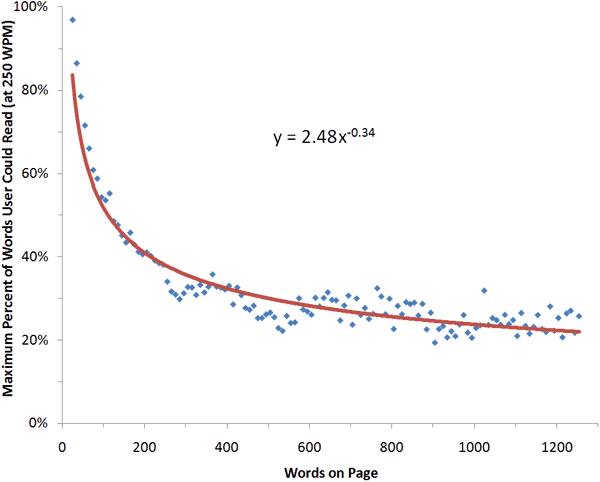
Caption: Most people scan text. They don’t read it.
What to do about this
Make your content scannable. Which is to say:
- Break content into sections of 400-500 words each
- Use descriptive subheaders for each section
- Use bullet points wherever possible
- Keep paragraphs short: Five lines or less
- Put special terms and important new ideas in bold
- Add an image every 300-400 words
- Include descriptive captions with every image
2. Most shares happen via email.
We talk so much social media shares, but the bulk of sharing is actually not done through social media.
It’s done through email.
Doubt this? Here’s one study from the Columbia Journalism Review about how people share content (https://www.cjr.org/innovations/why_do_people_share_stories.php):

Caption: More people share content via email than via social media.
And another study about how people share content:
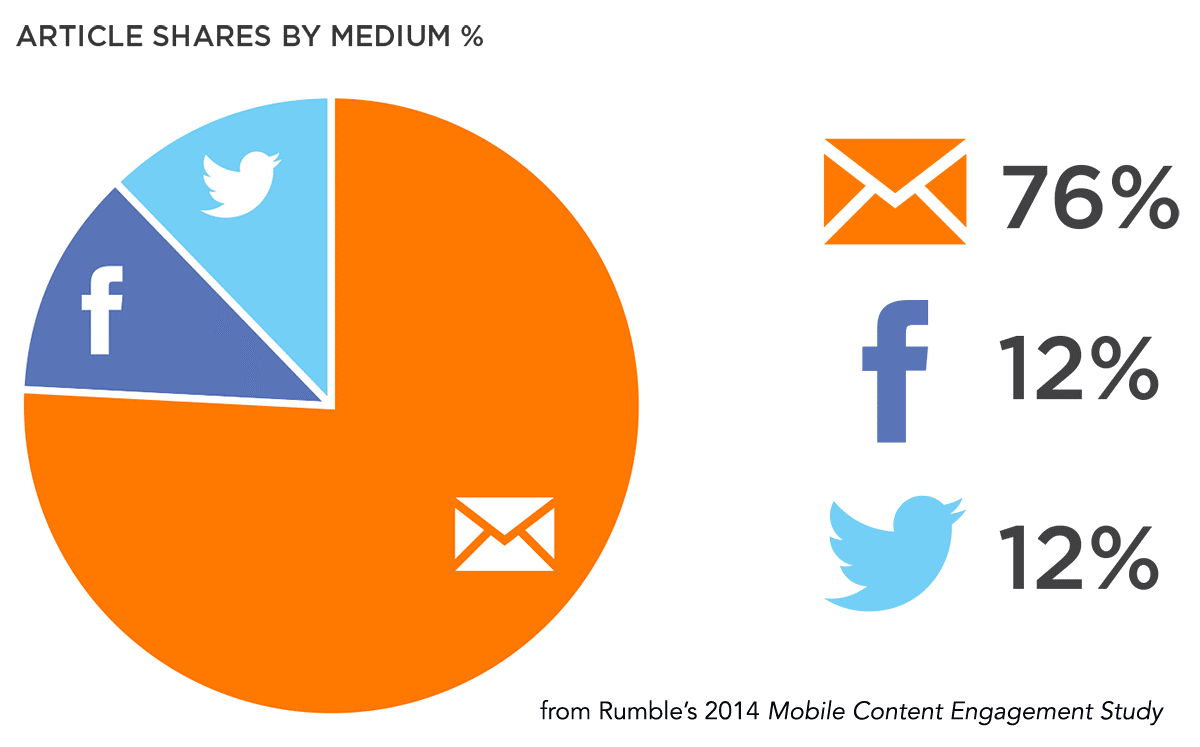
And another study from earlier this year about how B2B buyers (http://www.demandgenreport.com/resources/research/the-2017-content-preferences-survey-report) share content:
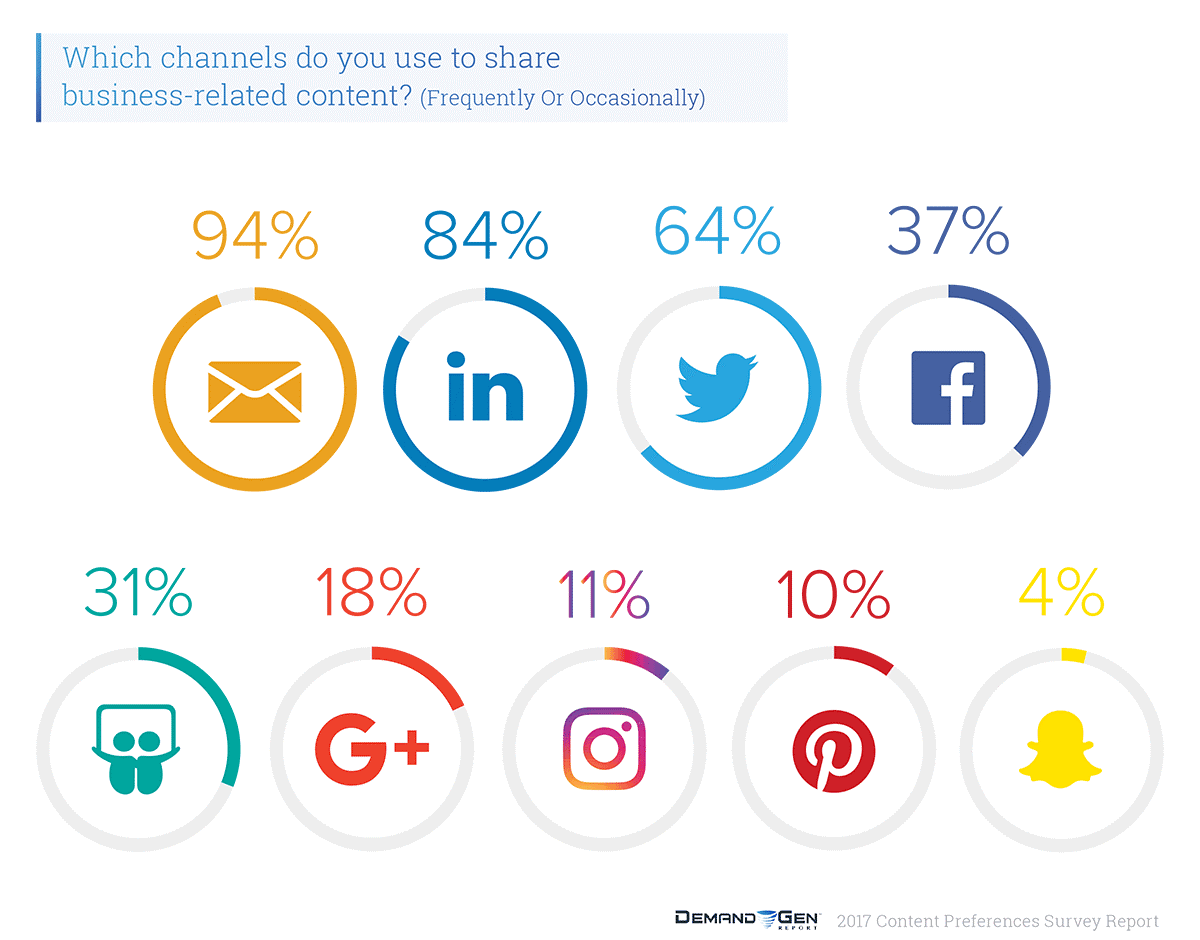
Surprising, right? But there it is. It’s hard to argue with three separate studies that show the same thing.
How to apply this
You’ve probably got social share buttons up on every content page of your site (if you don’t, put that at the top of your to-do list now). But do you have a “share via email” button? Have you tested it lately? Have you tested a call to action to ask people to specifically share via email?
3. Mobile rules.
Mobile has taken over the web. It happened a few years ago, actually – around about 2015, mobile traffic on the internet outpaced desktop-based traffic.
So… tell me: Is the content on your site optimized for mobile users?
Here’s a few ways to tell:
- Do your pages load in 2 seconds or less? Mobile users abhor slow sites.
- Are the lead gen and other forms on your site easy to complete on a mobile device?
- Are your content pages easy to read, with good-sized type and simple, logical navigation?
That’s all a good start, but to really be mobile-first, you may need to create an app. According to research from Flurry, 92% of total mobile minutes in 2016 where spent with apps. Only 8% of mobile time was spent in browsers.
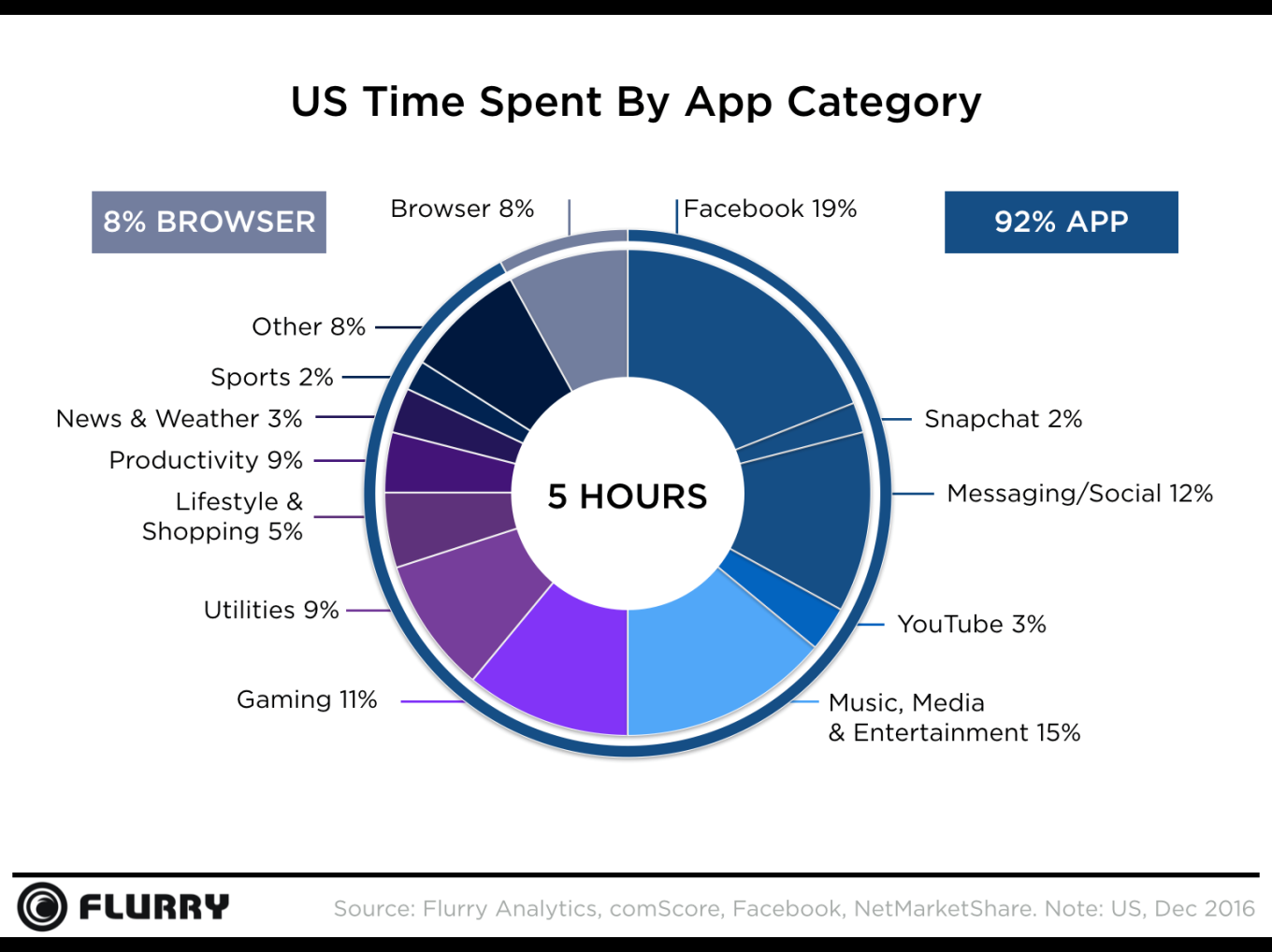
Caption: Mobile rules the internet, and apps rule mobile usage.
4. Video
According to Cisco, “By 2020, video will account for 82% of all consumer
internet traffic“.
‘Nough said.
So, given that video is all but “eating the internet” is your company investing in video content?
If not, why not?
The most common reason to hold back is cost. And while you can go right ahead and blow $10,000 on a three-minute video, that’s not necessary. You don’t need a massive budget to get started.
Here’s a short list of must-have items for an in-house video marketing program:
- A good microphone. $300. Yup. Surprisingly, people will often overlook mediocre visuals with videos. But if the audio is bad, they’ll judge you more harshly.
- A microphone stand, a “pop filter”, at least two lavaliere microphones (to pin to shirts), and some wind buffers. $150.
- Professional video editing software. $300. Even if you hire someone to edit your videos for you, it’s smart to be able to make small tweaks on your own.
- A “video camera” stand to hold a high-quality smartphone, an iPad, or an actual video camera. $60.
- A lightbox set. $80. Consider adding other lights for another $80. Good lighting is critical.
- A good video editor. They can be found on Fiverr or other freelancing sites. Expect to pay about $50-$75 an hour for a good one.
- An iPhone or iPad. Optional: If you really want to splurge, consider something like the Panasonic LUMIX GH4 DMC-GH4GC-K 16.05MP Digital Single Lens Mirrorless Camera (https://www.amazon.com/Panasonic-GH4-DMC-GH4GC-K-Mirrorless-Cinematic/dp/B00L8YWT5G/). It’s a workhorse for many video production companies. Or, if you like, find something suitable for about the same price ($1,000-$1,200).
Total cost for your starter video production setup: $970.
Take note: You can also use all the audio equipment to do webinars and podcasts, so that’s one way to defray the costs.
5. Digital assistants and voice search.
You’ve surely heard about the rise of podcasts. And I bet you’ve listened to at least one audiobook. But have you tried doing a voice search yet?
Though Google has said that 20% of searches were done by voice in 2016, some very smart marketers (http://www.seerinteractive.com/blog/ok-google-focus-voice-search-2017/) say they’re still going to hold off on diving into voice search optimization just yet.
Given that there’s so much else to do, I think this makes sense for now. But do keep monitoring voice search. And definitely convert at least some of your content to audio. It’s a preferred way to consume content for many users.
For example:
- Consider a podcast
- Consider making audio versions of your most popular content. Like Jeff Bullas has done here:
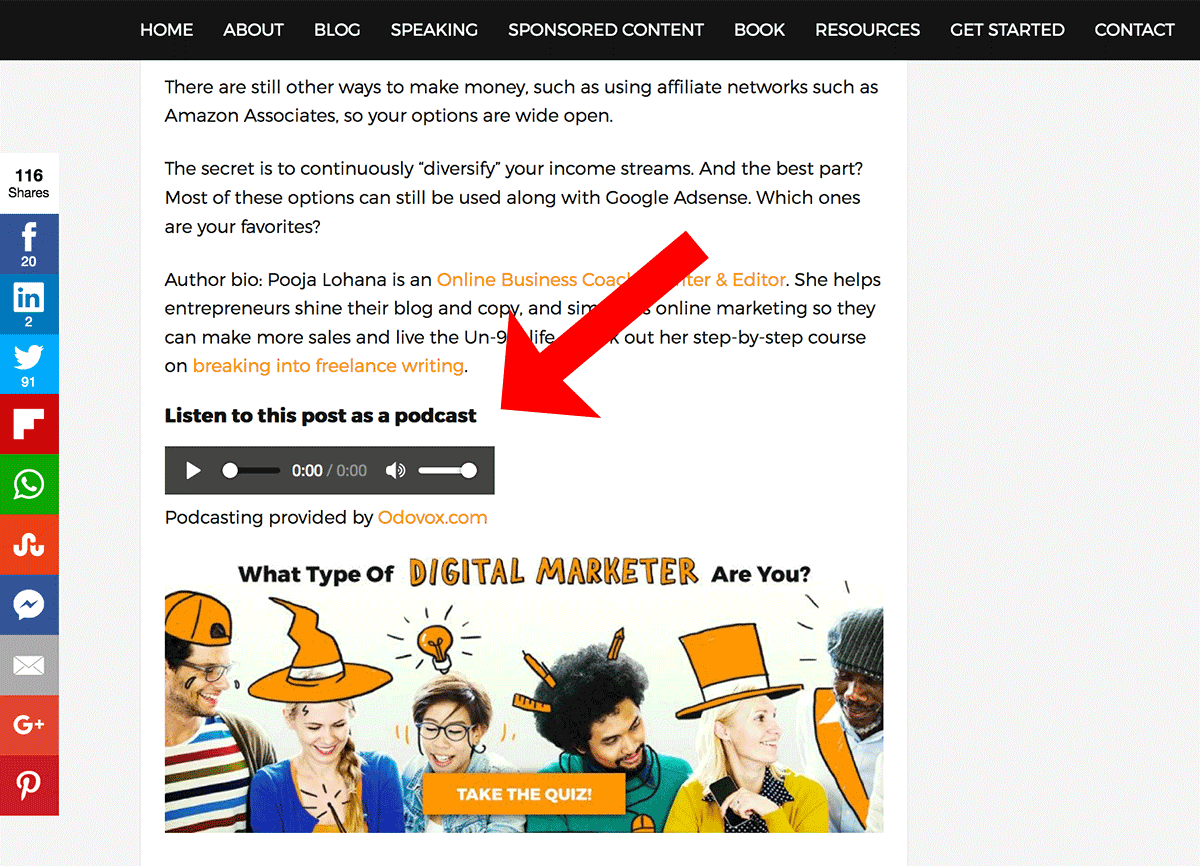
Caption: Adding an audio component can get more engagement for your content.
Notice that interactive quiz, too. More about that in a moment.
6. Trust is at a premium.
The “fake news” phenomena didn’t come out of nowhere. Trust has always been at a premium, but it’s even more precious today. In fact, you could argue that content marketing has become popular specifically because advertising has become so distrusted.
Here’s a useful table that shows who trusts what, and how much (https://www.nielsen.com/content/dam/nielsenglobal/apac/docs/reports/2015/nielsen-global-trust-in-advertising-report-september-2015.pdf):

Caption: Consumers don’t trust all messages and advertising equally.
How to apply this:
- Notice how “recommendations from people I know” tops the list for trust? That suggests that getting more people to share your content with their peers has big benefits. Perhaps via email…
- It also means that testimonials and reviews of content from peers or even micro-influencers can lend a lot of credibility to your content. For example, if someone has said nice things about your newsletter, or your blog, it might help to make those words visible to visitors.
- Embrace case studies (https://www.getmintent.com/blog/categories/customer-spotlight-stories/). Readers may not know the people in the case study, but if they’re like the subjects of the case study, you’ll build a lot of trust. That may be why case studies are routinely at the top of the list of the most effective content formats.
- If it’s at all relevant to your business, start investing online reviews and other forms of user generated content (also known as “UGC” (http://searchengineland.com/reviews-ugc-much-influential-consumers-ads-study-277507).
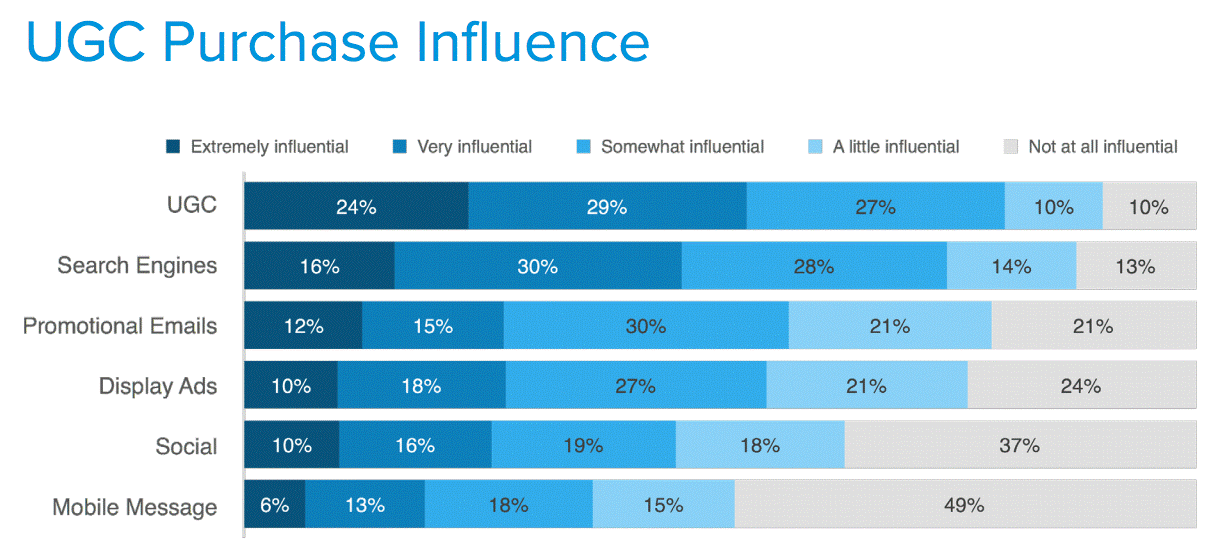
Caption: User generated content (UGC) influencers buyers more than anything else.
7. Chat bots.
You might think of chat bots more as a function of customer service or sales, but remember how the customer experience is becoming part of marketing’s responsibilities? And how we content marketers urgently want sales and customer service to use more of our content? Maybe incorporating more content into bots is a way to get there.
Chat bots are also an interesting development for artificial intelligence in marketing… another big trend that will eventually shape how we all consume content.
8. Virtual reality.
While I’m skeptical about how widespread the use of virtual or augmented reality is now, it would be a mistake to not include this trend. Google Glass may have fallen flat, but Outbrain (http://www.outbrain.com/blog/four-trends-changing-the-way-we-consume-content
) predicts that by 2020 “over 200 million virtual reality headsets to be sold — creating a global market worth $40 billion.” And 2020 is only two and a half years away.
What do to about virtual reality
Again, I think it’s premature for most brands to even think about launching an augmented reality campaign right now. But you can start playing around with what’s possible.
Snapchat’s overlays are a simple form of augmented reality, as are Facebook’s masks. Lowes also has an augmented reality app that will guide you through some of their stores. And, of course, you can play Pokemon Go.
One thought… if Lowes can guide people through their stores with augmented reality, maybe your next corporate event could try something similar.
9. Interactive content.
What’s the one thing every content marketer wants more of? After budget, it would have to be engagement. Interactive content (http://contentmarketinginstitute.com/wp-content/uploads/2016/06/Ion_CMI_InteractiveContent_Report_Final.pdf
) can deliver that.
Whether it’s an interactive poll, a quiz or an assessment, making information more interactive grabs and holds people’s attention. One CMO recently told me his company’s online assessment tool is their #1 way to get great new leads.
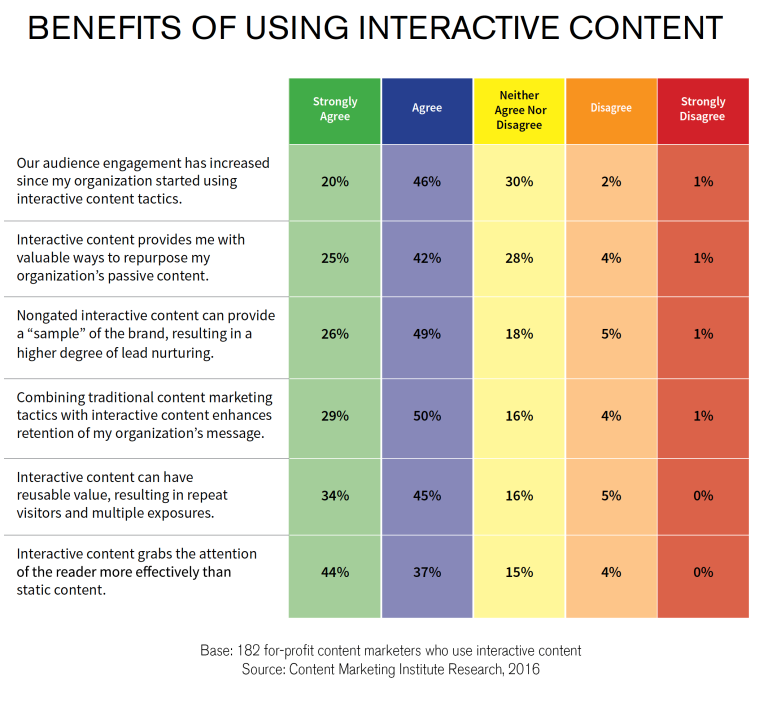
Caption: Interactive content is exceptionally effective – especially for lead generation.
10. Visual content.
If you’re skeptical about the influence of visual content, consider this: We’ve now got two major social media platforms that are pretty much exclusively about visual content: Instagram and Pinterest.
Content marketers have known the power of visual content for some time. For example, social media posts with images tend to get nearly twice as much engagement. Just adding an image to a blog post reportedly improves its SEO rankings (http://backlinko.com/search-engine-ranking).
And, of course, there’s infographics.
They still get more shares and links than many other types of content, but marketers often skip over infographics because they assume they’re too expensive. And if you go through an agency, you can easily spend $2,000 or more on an infographic.
In some cases, that’s the right call. But I urge you to try making simpler “infographics” more often. These little infobytes of visual data can get a lot of shares, and they liven up long blocks of text.
Bonus: Personalized content
With the right content management system, it is possible to serve up content customized for each user. You can do this via
- Email messages
- Website content
- Custom call to actions
- Personalized landing pages
- Personalized social media messages
- Personalized SMS or push messages
Personalized content may actually end up being the next big push in content marketing 2.0. Though we’ll probably end up incorporating all these content trends into delivering optimized messages to customers and prospects.
Conclusion
Blog posts and ebooks are a great start for content marketing, but if you want to stay competitive, you’ll need to vary your content formats. Some customers and prospects will just naturally prefer a video, or an online quiz, or an infographic instead of the written word.
It’s smart marketing to make it easy and pleasurable for them to engage with your content – just like it’s smart business to make it easy and pleasurable to do business with you. If you need help managing your content and marketing initiatives, we recommend that you check out this free tool called Mintent. Mintent is a content marketing software that allows you to plan, create, publish, measure & optimize all of your campaigns in one place, it’s free for up to 5 team members. Sign up for a free account with Mintent here.

 Delicious
Delicious Digg
Digg StumbleUpon
StumbleUpon Propeller
Propeller Reddit
Reddit Magnoliacom
Magnoliacom Newsvine
Newsvine
Comments
Post new comment